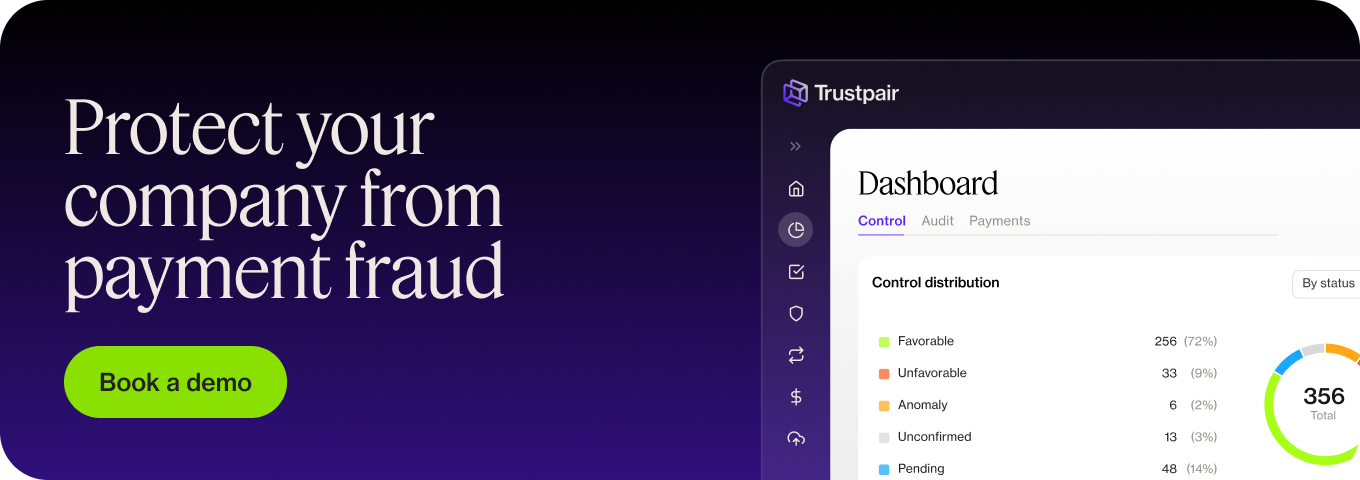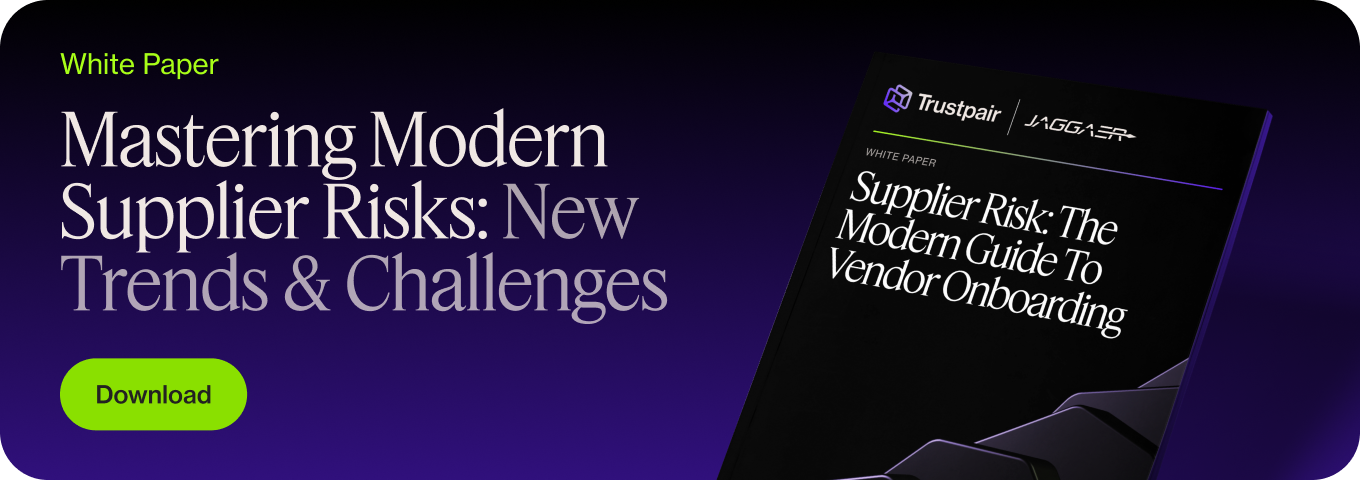Working with any external partner could create a gateway for fraud – but third-party monitoring can help protect your business.
Imagine a fraudster impersonating a supplier, spoofing their email address, and changing the payment credentials to their own. Organizations that aren’t monitoring their vendors or performing proper risk management might fall victim to huge losses. Read on to learn more.
Trustpair helps you prevent fraud by securing your business and each third-party vendor across the supply chain. Request a demo!
Why is third-party monitoring crucial for risk management?
Third parties are any entity that works with your organization, like;
- Suppliers
- Service providers
- Contractors
- Freelancers
- Distribution centers
- Re-sellers
But when you partner with another organization, you essentially multiply all of your operational risks by two. This is because every collaboration means you are dependent on the partner – and their stability. Any disruptions on their end are likely to affect your business continuity, too.
That’s why due diligence is crucial – it gives your company a bit of insight before you start outsourcing. While partners typically have no control over how each other is run, ongoing third-party monitoring will allow you to gain transparency over any developing situations and react accordingly to mitigate the fallout. Therefore, third-party risk management should be high on the priority list of all companies.
Larger companies have more to lose. The more third parties you work with, the greater the risks imposed on your business. But continual data collection and analysis is arguably the most important factor in managing those risks.
What type of third-party risks are there?
Generally speaking, there are three major categories of vendor risk. These are:
- Cybersecurity
- Reputational
- Business
These three categories of risks need to be addressed with specific third-party risk management procedures.
Cybersecurity and fraud risk
Third parties with weak cybersecurity controls increase the risk to your business. Most businesses use automation within financial processes these days, but this does heighten the risk of cybersecurity events. Plus, a data breach or ransomware attack of a third party can include your data, credentials, or shared sensitive information in the fallout.
One example of the cyber security risk associated with third parties is invoice fraud. If your partner gets hacked, fraudsters might send fake invoices to your team, alongside a notice of changed bank account details.
Likewise, third parties increase the risk of vendor fraud, such as the set up of a fake shell company that appears legitimate. Fraudsters might do this as part of their reconnaissance on your business, in order to learn about your systems before they strike.
Without a tool like Trustpair to monitor changes in third party credentials and detect suspicious activity, your team might be none-the-wiser and pay straight into the criminal’s accounts.
A secure vendor onboarding is the first step to an effective successful third-party strategy. Download our white paper for tips and best practices!
Reputational risk
Reputational damage catches like wildfire.
Being publically associated with another entity aligns you with their actions. This relates to the environment, sustainability, workplace culture, and labor laws. If one of your professional partners damages their own reputation through these means, your reputation is placed at risk too.
Take the 2015 Volkswagen Emissions scandal as an example. The car manufacturer was accused of installing software that would allow them to cheat on emissions tests. Alongside financial effects, Volkswagen took a huge reputational hit by experiencing a sharp decline in sales.
But Volkswagen’s third-party partner, Bosch, was later accused of supplying the technology. This led to their own reputational downfall, with over $327 million paid out in settlements.
The team at Bosch was allegedly not aware of how their technology was being used, pointing to errors in their third party monitoring procedures. This has since led to a complete overhaul in the due diligence, compliance, and ethics standard at the company.
Business Risk
Finally, there is an overall increased risk to the business if due diligence is not performed and maintained.
For example, changes in leadership generate new ultimate beneficial owners. It’s important to have visibility into a partner’s beneficial owners since this can highlight their own third-party relationships or links to criminal activity, like:
- Money laundering
- Terrorist financing
- Tax evasion
With full knowledge of the business operations of third parties, the risks associated with your own business is reduced. At the bottom line, this preserves company finances.
What to check for effective third-party monitoring and risk management?
There are three areas to focus on when checking third-parties as part of your risk management program. These are:
- Litigation
- UBOs
- Financial records
Litigation checks
Litigation checks are important because they may highlight past problems with a supplier that fails to fulfill their end of the contract. Alternatively, if they’re accused of breaking enterprise laws that could impact your reputation, you need to know.
Although some legal documents are not necessarily shared with the public, you can check the likes of:
- Ongoing, pending or threatened litigation
- Certifications, licenses or permits
- Historic lawsuits
- Contracts
The easiest way that you can check these is by asking the potential partner to provide them. It would be a huge red flag if they refused, as litigation checks are a common part of due diligence.
If, for some reason, you can’t contact them directly, then litigation search software does exist.
Ultimate Beneficial Owners
UBOs (or ultimate beneficial owners) are the people who benefit when businesses do well. But in cases of money laundering, terrorist financing, tax evasion, or other illegal activities, the ultimate beneficial owners of a company may be hidden.
In most countries, there is a national register for UBOs and it’s a legal requirement for company leadership to declare their beneficiaries. It means you can check UBOs without the need of specific technologies just by checking the register.
In order to compare these details with other company information, platforms like Trustpair exist. We provide access to vendor data (such as company location and whether it appears on any blacklists) in order to help our customers evaluate the activity of their third parties.
This way, your compliance team can gain insight into suspicious transactions, spending anomalies or financial relationships. In the case you discover any undisclosed red flags, you can hold off on contracting the new vendor.
Financial Records
Similarly, financial records may be regulated one way in the States, but totally different elsewhere. This makes it difficult to fully evaluate the financial position of vendors, as well as spotting potential fraudulent activity.
Platforms like Trustpair can help you get your vendor banking data and financial credentials right. Likewise, we validate accounts in compliance with SOX law regulators and help to prevent money laundering.
What are the best practices for third-party monitoring in risk management?
There are two stages of action that you can take during third-party monitoring; initial due diligence and ongoing monitoring. Assuming you’ve already completed the due diligence phase and contracted a new vendor, the ongoing monitoring begins.
Here, it’s essential to implement best practices like setting up:
- Automated tracking
- Triggers for alerts
- Risk tolerance limits
Let’s break it down.
Automated tracking
Since it’s an ongoing process, third-party monitoring should happen continuously with automation. This is for two reasons:
- It would require very heavy lifting to do manually
- Automation tracks in real-time
Being able to work in real-time softens the impact of any events. When risks turn into problems, a quick reaction can be the key to preventing impacts on your organization. Finance automation allows you to make quick decisions with confidence since you have access and oversight across the data you might need.
Moreover, continuous tracking left to manual work opens up the chance for human error. Not only could it become tedious, but your people could better spend their time elsewhere, on value-adding tasks.
For example, Trustpair automatically and continuously audits third party information . Depending on what’s collected, we then send live notifications in case of changes or suspicious activity.
Triggers for alerts
Risk isn’t a static measure – it changes based on business and environmental factors. But mitigation is more than just tracking – your people should be notified of any increase in the risk profile.
Since finance digitization is a key challenge for finance departments in 2023, one example of a trigger could be for tracking Google trends data. If a third party’s searches or mentions are increasing, it might be cause for concern. Triggering an alert to your team when it’s mentioned more than 25 times in one week, for example, will warn your staff that something in the risk profile has changed.
At Trustpair, we automatically check any supplier request to change their banking information. This ensures that the genuine merchant is making the change, instead of a fraudster who has impersonated them.
Risk tolerance limits
Setting specific limits for risk tolerance means creating your own scoring matrix. With the chosen factors, you can calculate risk appetite, which is the level of risk deviation your business is comfortable with. This is useful because it lets you know exactly when to intervene.
Having a mapped out system allows your team to make informed decisions around working with third parties, leaving no room for emotional bias. This means that your organization should be mitigated from larger risks, no matter how good the products or services of third parties are.
As part of risk appetite calculations, you can check if third parties have developed their own risk statement or enterprise risk framework. And if one of your third parties exceeds the set limit, you can begin cutting ties.
How can you effectively implement third-party monitoring in risk management?
Automated solutions for third-party monitoring are the most robust way to reduce the risk associated with external fraud . Automation can provide continuous monitoring that humans just can’t perform manually.
Trustpair helps with vendor risk management by systematically validating financial account information and company information. With unrivaled technology, we work with the most-reliable third-party data in the world by centralizing thousands of data points from external and internal sources.
Moreover, these controls can be seamlessly integrated with your current system to provide 100% effectiveness in blocking fraud. Request a demo.
To conclude…
Third-party monitoring is about performing ongoing due diligence on external partners in order to protect the financial and information security of your business. Different measures will feed into a risk assessment, and technologies like litigation search tools or bank account validation can be used during vendor management. The monitoring should inform any remediation strategy, prevent data breaches and third party fraud by allowing you to set your own security controls when working with third parties.


